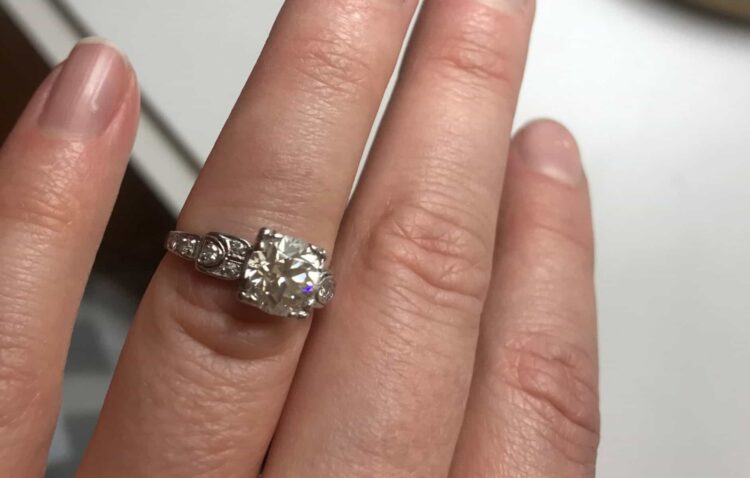Diamonds aren’t always forever — and as stunning they look, they may not be worth as much as you think when you try to sell your engagement ring.
My ex-husband presented me with a gorgeous engagement ring as part of a jaw-droppingly romantic proposal in Paris in March 2012.
The scene could not have been drafted better by a Hallmark Channel screenwriter. I was traveling with a friend and visiting my younger brother, who was studying abroad. I had thought my ex was staying home in our apartment in New York.
Unbeknownst to me, he smuggled himself across the Atlantic. With help from my brother and my friend, he orchestrated a surprise rendezvous at the Place de la Concorde, at the foot of the Champs-Élysées. It was early evening and a light rain was falling, making the pavement glisten. The Eiffel Tower sparkled on the horizon across the Seine.
Suddenly, I turned around and he was standing in front of me, wearing a suit and tie, and holding an umbrella. It took me a second to recover from the shock, but I soon guessed why he was there. Sure enough, he pulled a box holding a diamond ring out of his coat.
It wasn’t just any ring; it was the exact ring I had been eyeing weeks before (and had semi-casually mentioned to him) — a vintage 1930s piece with a 1.45-carat Old European cut stone, open-worked shoulders and a platinum band. It cost about $15,000.
I was intoxicated by the surroundings, by my ex’s smile, by the ring, and by the grandiosity of his gesture. When he popped the question, two words spilled out of my mouth: “Of course.”

Unhappily ever after
If our life had remained as beautiful as that moment, we would probably still be married. Obviously, things didn’t turn out that way. The theatrical magic swiftly gave way to less glamorous reality. After my ex finished sweeping me off my feet — he sprung for a pricey dinner for the four of us at a famed bistro, and then took me to a suite he had reserved at the five-star Hôtel de Crillon — he got fractious and irritable.
Maybe he was tired from all of his planning and traveling, and squeezing those efforts around his full-time job as a financial analyst and the MBA classes he was taking. Maybe I was tired, too. Maybe I didn’t act as awestruck as he had hoped I would be, and he felt disappointed. Whatever the cause, we started bickering within 24 hours of our engagement.
I assumed we could work through our difficulties. “Marriage softens sharp edges,” someone once told me. Two and a half years later, we had a magnificent (and expensive) wedding at Brooklyn Botanic Garden, we had a honeymoon in Iceland and London, and we settled into married life. But the sharp edges never wore down.
We had many happy moments, but they came to be overshadowed by bitter arguments. I started to think about how our relationship was based more on appearances — the perfect proposal, the perfect wedding, the Instagram-perfect life — than it was about honest emotional investment.
My ex told me, for instance, that he suffered from nightmares for weeks before he proposed. He wasn’t worried that I would say “no,” or that something might go horribly awry. He was tortured by the thought that I would find out what he was up to, ruining the surprise. I was troubled that what concerned him most was showing off and impressing me and other people, and not just…loving each other.
Deciding to end it
I started to pull away from him. I immersed myself in a journalistic project, and I began to develop feelings for the man I was writing about. The fighting between me and my ex intensified, and I decided to leave him in 2018. My ex filed the divorce papers and we reached an amicable settlement.
I kept my beautiful vintage engagement ring. Its $16,500 appraisal was helpful to me when I bought a Manhattan apartment in 2021 and needed to show a healthy balance sheet to a co-op board. But like the relationship it signified, the ring’s dollar value on paper turned out to be more fantasy than reality.
Engagement ring sellers do a brilliant job of dancing around the truth about what you might be able to get if you try to sell your treasure. The co-founder of engagement ring auction site I Do Now I Don’t, Mara Opperman, told BRIDES magazine recently that “most of the time we see people getting back anywhere between 40 to 75 percent of the ring’s original value.”
However, the site itself tells prospective buyers that pieces can be purchased “for more than 80% off retail.” If buyers are getting “80% off retail,” then sellers cannot possibly be recouping most of what they paid.
At first, I didn’t want to sell my ring. I thought about keeping it locked in a box in my apartment and passing it down to a relative as an heirloom. Sometimes, I took it out and tried it on and let waves of nostalgia wash over me. But after a while, hoarding a costly rock and clinging to ideas of what might have been felt ridiculous. It was time to move on.
A bittersweet goodbye
When I began to Google how to sell my ring, I saw there weren’t many options. Blogs advised using speciality auction sites or eBay, or attempting to negotiate a deal with a retailer, or just walking into a pawn shop. I tried contacting some retailers, but there were no bites. I also looked into using a specialty auction site. But the company asked that I ship the ring to its offices for testing, and I didn’t feel comfortable putting it in the mail.
Eventually, an ad for an established jewelry resale business appeared on my social media feeds. The company had an office in Manhattan and I could bring my ring for an appraisal in person. I knew it wouldn’t offer top dollar — the business served as a middleman to wholesalers and retailers. Still, I felt like it was worth a shot.
The appraiser I met with seemed delighted. “Yep, that’s definitely an Old European cut diamond,” he said approvingly, as he examined the stone through his jeweler’s loupe. I detected a rising eagerness in his voice. “I can give you $3,200,” he said, finally.
I sank back into my chair and let the number sink in. It was lower than I had anticipated. I thought about taking the ring back home and trying to sell it on eBay. But the man’s face changed my mind. I could tell by his expression and the excitement in his eyes that getting my ring would be a “win” for him. Maybe he would get a nice chunk of the upside when the company resold it.
If much of the value of an engagement ring was supposed to be the joy it brought to people, then I wanted to be sure it made someone happy. I picked up the ring and put it on my finger one last time. And then I handed it back to the appraiser.
“That’s fine,” I said. “I’ll take that.”






